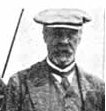Gerard De Geer
| Gerard De Geer | |
|---|---|
 |
|
| Born |
20 November 1858 , Sweden |
| Died | 24 July 1943 (aged 84) Stockholm, Sweden |
| Residence | Sweden |
| Citizenship | Sweden |
| Nationality | Swede |
| Fields | Quaternary geology |
| Institutions | |
| Alma mater | Uppsala University |
| Doctoral students | Ernst Antevs |
| Known for | Varve geochronology |
| Notable awards |
Vega Medal (1915) Wollaston Medal (1920) |
| Children | Sten De Geer |
Baron Gerard Jacob De Geer ForMemRS (20 November 1858 – 24 July 1943) was a Swedish geologist who made significant contributions to Quaternary geology, particularly geomorphology and geochronology. De Geer is best known for his discovery of varves.
De Geer was born in , Sweden, on October 2, 1858. His family, originally Dutch nobility who had emigrated to Sweden in the early seventeenth century, included prominent industrialists and politicians. Both De Geer's father (Louis De Geer) and older brother were Prime Minister of Sweden, and De Geer himself was a member of the Swedish Parliament from 1900 to 1905.
De Geer graduated from Uppsala University in 1879, after joining the Swedish Geological Survey the previous year, and began what was to be his life's work studying the late Quaternary deposits and landforms of southern Sweden. De Geer's early studies of raised beaches, used to reconstruct glacio-isostatic sea level changes, and his mapping of glacial moraines to reconstruct the extent of the last Scandinavian ice sheet and its pattern of deglaciation (the particular type of moraine he studied is now referred to as De Geer moraine), were well received. However, De Geer is most famous for discovering varves and pioneering their use in geochronology.
During fieldwork in 1878, De Geer noticed that the appearance of laminated sediments deposited in glacial lakes at the margin of the retreating Scandinavian ice sheet at the end of the last ice age, closely resembled tree-rings. In his best known work Geochronologia Sueccia, published in 1940, De Geer wrote "From the obvious similarity with the regular, annual rings of the trees I got at once the impression that both ought to be annual deposits" (1940, p. 13).
...
Wikipedia
